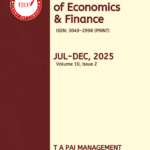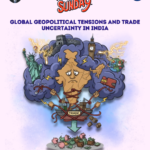
–Winston D’Souza[1] and Sushma Kudva[2]
Introduction
Indian Rupee (INR) has depreciated against US Dollar (USD) the most (about 8.3 percent) in comparison with other major currencies such as Euro (EUR), Great Britain Pound (GBP), Japanese Yen (JPY) and Chinese Yuan (CNY) in the last five years. The USD appreciation is due to various factors such as an increase in India’s trade deficit, fears of a trade war, surging oil prices and instability in Eurozone among many others (Anoyn, 2018). The changes in the exchange rates will affect the firms from different industries in three ways.
First, transaction exposure, which is created by the transactions of the firm involving cash flows resulting from activities such as imports, exports, payment/receipt of interest royalty etc. If there is a change in the exchange rate consequent upon the transaction, the revenue and profit margins will be disturbed. For instance, an Indian company exports goods invoiced in USD receivable after three months without knowing the exchange rate of USD/INR. If USD appreciates against INR for three months, the exporter’s INR revenue will decrease. Second, the changes in exchange rates may result in gains or losses in the consolidation of financial statements of foreign subsidiaries. This exposure is known as translation exposure. Third, the changes in the exchange rates might affect the firms’ competitive position in the market and the long-term cash flows. This is known as economic exposure (Eun & Resnick, 2012). The nature of the industries will have decided if they are going to be benefitted or affected by the exchange rate changes.
The net-exporting industries such as Information Technology (IT) or Pharmaceutical industries will gain in the short term due to the USD appreciation. On the other hand, net importing industries such as Oil, Chemicals, and Minerals will lose due to the USD appreciation (Iyer, 2018). However, the change in the exchange rate also affects the firms catering to the domestic market. For instance, the domestic currency appreciation (depreciation) might make the cost of products with imported component cheaper (costlier) making it advantageous to domestic firms.
In this paper, we analyze the effect of USD appreciation against INR on different industries. The second section describes the sample industry analyzed, methodology and the sources of data. In the third section, we analyze the effect of USD appreciation for industries chosen. The conclusion is written in the last section.
Methodology
We chose six industries to analyze the changes in the exchange rates. They are Automobile, Commodities, FMCG, Information Technology (IT), Metal and Pharmaceutical industry. Banking and Financial Services industries were excluded from the study. We used the sectoral indices of the National Stock Exchange (NSE) as a proxy to analyze the implications of USD appreciation on these industries. The descriptions of the NSE sectoral indices used in this study are presented in table 1.

Table 1: Details of NSE sectoral Indices used in this paper
Source: National Stock Exchange.
Note: N is number of companies in the index. % M-Cap is percentage of the free float market capitalization of the stocks forming part of the industry as on 31st March 2016.
The foreign currency income (FCI) and foreign currency expenses (FCE) of companies forming the industry was collected from CMIE Prowess database for 10 years from year ended March 2009 to March 2018.
The industry’s exposure to exchange rate changes of USD/INR is estimated using the capital market model proposed by Adler & Dumas (1984). The capital market model explains the exchange rate sensitivity by regressing the returns of sectoral index against the exchange rate changes as presented in equation (3):
Rit = α + β1RUSDINRt + εt (1)
Where α is the constant, Rit is the weekly return index i at time t, RUSDINRt is the weekly changes in exchange rates of USD/INR and εt is the error term. In this model, β1 measures the sensitivity of the index return to the exchange rate and considered as the exchange rate exposure. We used the log returns of both index and the USD/INR returns as returns of these asset classes follow log-normal distribution (Elton & Gruber, 1974). The β1 was estimated using the HRA (regression) function in the Bloomberg Professional Service.
Results and Discussions
The table below presents the foreign currency income of the sample industries from the year ended March 2009 to March 2018.

Table 2: Foreign currency income (₹-billion) for ten years
Source: CMIE Prowess
Note: The foreign currency income is the total of the foreign currency income of the constituent companies.
The total foreign currency income of the IT firms constituted in NIFTY IT index was ₹2,450.91 billion during 2018 which was highest among all the industry. This was followed by commodities and metal industries. Revenue as a percentage of foreign currency income to total income was highest for IT and Pharma industries with 87.75 percent and 58.64 percent respectively for the year ended March 2018. This trend was seen throughout the study period. Thus it can be inferred that the USD appreciation will increase the profit margins of IT and pharma industries in the short run (Pramanik, 2018).
The foreign currency expense of the selected industries is displayed in table 3.

Table 3: Foreign currency expense (₹-billion) for ten years
Source: CMIE Prowess
Note: The foreign currency expense is the total of the foreign currency expense of the constituent companies.
The total foreign currency expense of commodities industry was ₹3,960.07 billion in the year 2018 which decreased from ₹7,560.73 billion in the year 2014. The decrease in the foreign currency expense of commodities industry can be attributed to the fall in crude oil prices from its peak. The foreign currency expense is about 2 times more than the foreign currency income of commodities industry. Thus, we can infer that the USD depreciation will adversely impact the cash flows of the commodities industry.
The foreign currency expense of IT industry was second highest. However, it can be noted that the foreign currency income is about 2.5 times of the foreign currency expense of IT industry. This provides a partial natural hedge for the firms in IT industry.
Commodities and Metal industries are net importing industry while IT and pharma are the net exporting industries. The foreign currency inflows and outflows of the automobile industry was almost equal. The FMCG sector had the negligible foreign currency transactions compared to the other industries.
The results of the capital market model estimated using equation (1) are presented in table 4.

Table 4: Results of Capital Market Model
* Significance at 0.10 level; ** Significance at 0.05 level; *** Significance at 0.01 level
Note: The reported values are adjusted β1 estimated using equation (1). The dependent variable is log weekly return of the index and independent variable is log of weekly USD/INR returns.
The IT and pharma industries had positive beta coefficients for most of the years indicating that the industry gained from the USD appreciation. Commodities index comprising firms from energy, chemicals and oil industries exhibited the negative relationship with the USD appreciation. This is in line with cash flow profile of these industries. The FMCG industry had lower sensitivity to the exchange rates changes. All the industries irrespective of their foreign currency cash flows or operations were significantly impacted by the exchange rate changes. This is in line with the findings of (Sikarwar, 2014). The figure 1 below depicts the annual return of the NSE sectoral indices and the changes in USD/INR spot rates.
Fig. 1: NSE sectoral index returns and USD/INR returns


Source: Bloomberg
As can be observed from the figure above the index returns drops when the USD appreciates for automobile, commodities and metals sector. This indicates that the negative impact of USD appreciation on these industries. The returns of IT and pharma indices increased slightly on the USD appreciation. However, the increase was not dramatic and significant. Interestingly, the returns of the FMCG index decreased with the USD appreciation. The detailed discussion on the industry-specific impact is presented below.
Automobile Industry
The adjusted beta is negative for eight years indicating the inverse relationship between exchange rate movements and index returns. The USD appreciation will have a negative impact on the auto industry on two fronts. First, a majority of the auto-makers in India rely on imported auto components. The local currency depreciation will make the import costlier. Second, the USD appreciation will also increase the fuel prices in general. This is likely to adversely affect sales growth (PTI, 2018).
Commodities Industry
The adjusted beta is negative for seven years indicating the inverse relationship between exchange rate movements and index returns during those years. India is the third largest importer of crude oil after USA and China. Thus a change in prices of crude oil has a direct impact on the economy leading to rising in Current Account Deficit (CAD), inflation and affect the domestic currency. The worst hit will be oil marketing companies such as HPCL, BPCL, and IOCL. This is because the sector is the major importer of crude from foreign countries and USD appreciation will adversely impact this sector.
The commodities industry also includes power generation and transmission companies. Majority of the power generation companies rely on coal import hence the impact of INR depreciation is negative. Besides, some companies from this sector have borrowed in foreign currency. For instance, companies like Tata Power, Power Grid Corp of India Ltd. and NTPC Ltd. have borrowed $0.705 million, $0.5 million, $0.642 million respectively in the year 2017-18. Thus the interest payments will rise along with the rise in principle amount.
FMCG Industry
The adjusted beta is negative for 7 years indicating the inverse relationship between exchange rate movements and index returns and indicates a direct relationship between 2012 to 2015. FMCG companies are all set to hike prices of their products between 2-5 percent due to the strengthening of US dollar and also hike in the raw material prices due to rising crude oil prices. Therefore, fluctuations in rupee value can affect them in several ways, which were not earlier salient. For instance, if rupee strengthens, the financial results of overseas subsidiaries of Indian MNC have lost their luster when consolidated with the Indian parent company’s results.
Metals Industry
The adjusted beta is negative for nine years indicating the inverse relationship between exchange rate movements and index returns. Recently, metals have lost almost a fourth of their value due to weak global demand and tariff war between US and China and a strengthening US Dollar. The minimum import price is in dollar per tonne and when the dollar becoming weaker, Indian steel companies have to take a price cut to remain competitive.
IT Industry
The adjusted beta turned out to be negative in the year 2017 because of the dollar value depreciation which came down to 63.042 and the adjusted beta is positive in the year 2018 showing a positive relationship between IT sector and rise in the dollar. The falling rupees will help IT services but the extent of gain depends on the number of the offshore business of an individual company. The leading companies like Infosys Ltd., Tata Consultancy Services Ltd., Wipro Ltd. and so on stand to gain from the falling of the rupee, this is because the major source of revenue is from US, Europe, South Korea.
Pharmaceuticals Industry
This sector is highly benefitted by dollar value appreciation as a majority of companies are exporters. Revenue from this sector is mainly from foreign sales, therefore, a rise in USD will benefit this sector. The companies like Dr. Reddy’s Laboratories Ltd. and Glenmark Pharmaceuticals Ltd. and so on earning a major source of revenue from South Africa, Latin America. This sector gains from fall in rupees. There was huge exports of bulk drugs, drug formulations, biologicals which stood at US$17.27 billion in 17-18 and it expects to grow by 30% by the year 2020 (IBEF, 2018).
Conclusion
This paper analyzed the impact of USD appreciation on six major industries of India. The NSE sectoral indices were used to analyze the effect of USD appreciation against INR on these industries. The data was collected from Bloomberg and CMIE Prowess. The foreign currency income and foreign currency expense of the selected industries were analyzed. The exchange rate sensitivity of these industries was estimated using the capital market model. The findings suggest that commodities, metals, and automobile industries are negatively affected by the USD appreciation. IT and pharma companies are gaining from the USD appreciation. However, the gain seems to be small. Interestingly, the FMCG sector was losing from the USD appreciation due to its operations in foreign countries.
References:
Adler, M., & Dumas, B. (1984). Exposure to Currency Risk: Definition and Measurement. Financial Management, 13(2), 41.
Anoyn. (2018). Rupee continues its free fall against US dollar: Should India be worried? Retrieved November 20, 2018, from https://www.businesstoday.in/current/economy-politics/rupee-vs-dollar-67-mark-usd-crude-oil-prices-indian-rs-value/story/276422.html
Elton, E. J., & Gruber, M. J. (1974). Portfolio Theory When Investment Relatives are Lognormally Distributed. The Journal of Finance, 29(4), 1265.
Eun, & Resnick. (2012). International Finance Management (4th ed.). Tata McGrawhill.
IBEF. (2018). Pharmaceutical Exports From India. New Delhi.
Iyer, S. (2018). A weaker rupee will help and hurt these sectors of the Indian economy. Retrieved November 20, 2018, from https://qz.com/india/1272592/a-weak-indian-rupee-will-help-and-hurt-these-sectors-of-the-economy/
Pramanik, A. (2018). Rupee fall may lift IT companies’ margins: Analysts. Retrieved November 20, 2018, from www.economictimes.indiatimes.com/articleshow/65762172.cms?utm_source=contentofinterest&utm_medium=text&utm_campaign=cppst
PTI. (2018, May 18). Falling rupee impacting auto industry’s bottomline: Toyota. Times of India. Mumbai.
Sikarwar, E. (2014). A Re-examination of Exchange Rate Exposure: Industry-level Analysis of Indian Firms. Global Business Review, 15(4), 867–882. https://doi.org/10.1177/0972150914543416
[1] First year MBA student, Justice K S Hegde Institute of Management, Nitte, India. Email: winston.dsouza0@gmail.com
[2] First year MBA student, Justice K S Hegde Institute of Management, Nitte, India. Email: sushmakudva@gmail.com

















Leave a comment